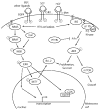Growth factors and oncogenes as targets in melanoma: lost in translation?
- PMID: 18159898
- PMCID: PMC2603613
- DOI: 10.1016/j.yadr.2007.07.015
Growth factors and oncogenes as targets in melanoma: lost in translation?
Abstract
If untreated at early stages, melanoma becomes a highly aggressive cancer with rapid metastasis to distant sites. Although cell biologic analyses have uncovered a multitude of signaling pathways involved in melanoma genesis and progression – including the MAPK, PI3K, and FAK pathways – efficacious therapies that target these cellular components have remained elusive. Genome-wide technologies such as microarray chips and array comparative genomic hybridization have generated genetic information that can identify cellular mechanisms critical for the induction and maintainence of the malignant phenotype. Thus, such data can guide the choice of a biologically relevant drug. However, these techniques have also identified melanoma as a genetically and biologically highly heterogeneous disease that likely requires individually tailored therapies based on the patient¹s individual genetic and biologic alterations. In addition, these techniques have generated a large body of data on candidate melanoma genes that await extensive functional validation to separate so called “driver” from “passenger” events. In this review, we cover several advances in melanoma therapeutics and their current limitations as well as emerging genomic, proteomic, and epigenetic strategies for the identification of critical cellular dependencies that may be tractable to therapeutic targeting.
Figures
Similar articles
-
Biology of Melanoma.Hematol Oncol Clin North Am. 2021 Feb;35(1):29-56. doi: 10.1016/j.hoc.2020.08.010. Epub 2020 Oct 26. Hematol Oncol Clin North Am. 2021. PMID: 33759772 Review.
-
Recent advances in melanoma research.Front Biosci. 2006 Sep 1;11:3003-13. doi: 10.2741/2028. Front Biosci. 2006. PMID: 16720371 Review.
-
[Proteomic identification of the new functional proteins in the EGF receptor-mediated signaling pathway].Seikagaku. 2007 Aug;79(8):781-5. Seikagaku. 2007. PMID: 17877025 Review. Japanese. No abstract available.
-
High expression of TAZ/YAP promotes the progression of malignant melanoma and affects the postoperative survival of patients.Pharmazie. 2018 Nov 1;73(11):662-665. doi: 10.1691/ph.2018.8499. Pharmazie. 2018. PMID: 30396386
-
Genetic progression of metastatic melanoma.Cancer Lett. 2004 Oct 28;214(2):133-47. doi: 10.1016/j.canlet.2004.06.049. Cancer Lett. 2004. PMID: 15363539 Review.
Cited by
-
Clinical Study on the Increased Incidence of Nodular Melanoma Cases Compared to Superficial Melanoma.Curr Health Sci J. 2021 Apr-Jun;47(2):298-305. doi: 10.12865/CHSJ.47.02.22. Epub 2021 Jun 30. Curr Health Sci J. 2021. PMID: 34765252 Free PMC article.
-
Induction of thyroid gene expression and radioiodine uptake in melanoma cells: novel therapeutic implications.PLoS One. 2009 Jul 10;4(7):e6200. doi: 10.1371/journal.pone.0006200. PLoS One. 2009. PMID: 19593429 Free PMC article.
-
Primary Melanoma Histologic Subtype: Impact on Survival and Response to Therapy.J Natl Cancer Inst. 2019 Feb 1;111(2):180-188. doi: 10.1093/jnci/djy086. J Natl Cancer Inst. 2019. PMID: 29912415 Free PMC article.
-
Histology-specific microRNA alterations in melanoma.J Invest Dermatol. 2012 Jul;132(7):1860-8. doi: 10.1038/jid.2011.451. Epub 2012 May 3. J Invest Dermatol. 2012. PMID: 22551973 Free PMC article.
-
Superficial spreading and nodular melanoma are distinct biological entities: a challenge to the linear progression model.Melanoma Res. 2012 Feb;22(1):1-8. doi: 10.1097/CMR.0b013e32834e6aa0. Melanoma Res. 2012. PMID: 22108608 Free PMC article. Review.
References
-
- Lasithiotakis KG, Leiter U, Gorkievicz R, et al. The incidence and mortality of cutaneous melanoma in Southern Germany: trends by anatomic site and pathologic characteristics, 1976 to 2003. Cancer. 2006 Sep 15;107(6):1331–1339. - PubMed
-
- Giblin AV, Thomas JM. Incidence, mortality and survival in cutaneous melanoma. J Plast Reconstr Aesthet Surg. 2007;60(1):32–40. - PubMed
-
- Balch CM, Buzaid AC, Soong SJ, et al. Final version of the American Joint Committee on Cancer staging system for cutaneous melanoma. J Clin Oncol. 2001 Aug 15;19(16):3635–3648. - PubMed
-
- Baade P, Coory M. Trends in melanoma mortality in Australia: 1950–2002 and their implications for melanoma control. Aust N Z J Public Health. 2005 Aug;29(4):383–386. - PubMed
-
- Coory M, Baade P, Aitken J, Smithers M, McLeod GR, Ring I. Trends for in situ and invasive melanoma in Queensland, Australia, 1982–2002. Cancer Causes Control. 2006 Feb;17(1):21–27. - PubMed
Publication types
MeSH terms
Substances
Grants and funding
LinkOut - more resources
Full Text Sources
Other Literature Sources
Medical
Miscellaneous


